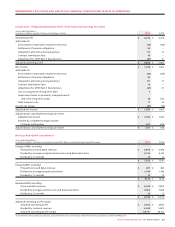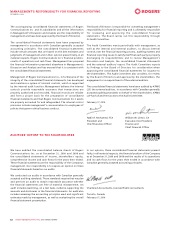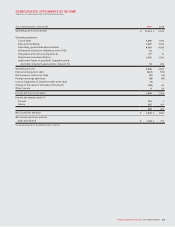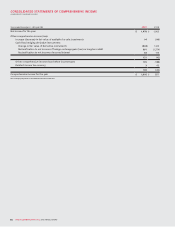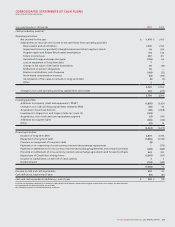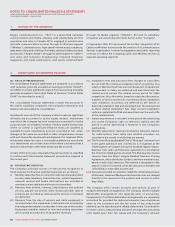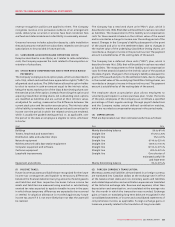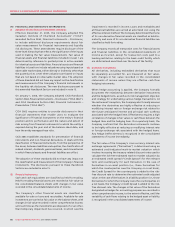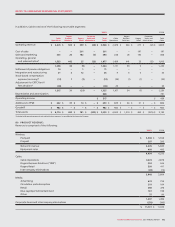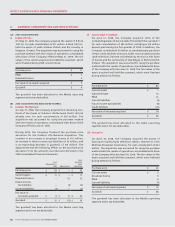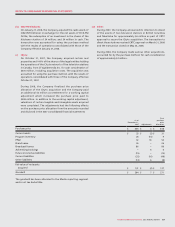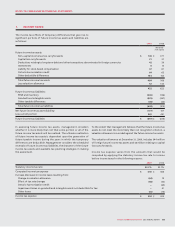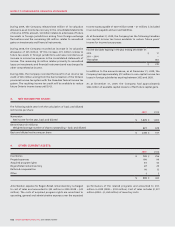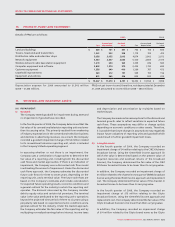Rogers 2009 Annual Report Download - page 87
Download and view the complete annual report
Please find page 87 of the 2009 Rogers annual report below. You can navigate through the pages in the report by either clicking on the pages listed below, or by using the keyword search tool below to find specific information within the annual report.
ROGERS COMMUNICATIONS INC. 2009 ANNUAL REPORT 91
NOTES TO CONSOLIDATED FINANCIAL STATEMENTS
(I) CAPITAL DISCLOSURES:
Effective January 1, 2008, the Company adopted the new
recommendations of CICA Handbook Section 1535, Capital
Disclosures (“CICA 1535”). CICA 1535 requires that an entity disclose
information that enables users of its financial statements to
evaluate an entity’s objectives, policies and processes for managing
capital, including disclosures of any externally imposed capital
requirements and the consequences for non-compliance. These
disclosures are included in note 21.
(J) NET INCOME PER SHARE:
The diluted net income per share calculation considers the impact
of employee stock options using the treasury stock method. There
is no dilutive impact of employee stock options after May 28, 2007,
due to the amendment to attach cash settled SARs to all new and
previously granted options.
(K) INVENTORIES AND ROGERS RETAIL RENTAL INVENTORY:
Inventories are primarily valued at the lower of cost, determined
on a first-in, first-out basis, and net realizable value. Rogers Retail
rental inventory, which includes videocassettes, DVDs and video
games, is amortized to its estimated residual value. The residual
value of Rogers Retail rental inventory is recorded as a charge to
operating expense upon the sale of Rogers Retail rental inventory.
Amortization of Rogers Retail rental inventory is charged to cost of
sales on a diminishing-balance basis over a six month period.
(L) DEFERRED FINANCING COSTS:
The direct costs paid to lenders to obtain revolving credit facilities
are deferred and amortized on a straight-line basis over the life of
the revolving credit facilities to which they relate.
(M) PENSION BENEFITS:
The Company accrues its pension plan obligations as employees
render the services necessary to earn the pension. The Company
uses a discount rate determined by reference to market yields at
the measurement dates to measure the accrued pension benefit
obligation and uses the corridor method to amortize actuarial gains
or losses (such as changes in actuarial assumptions and experience
gains or losses) over the average remaining service life of the
employees. Under the corridor method, amortization is recorded
only if the accumulated net actuarial gains or losses exceed 10% of
the greater of accrued pension benefit obligation and the fair value
of the plan assets at the beginning of the year.
The Company uses the following methods and assumptions for
pension accounting:
(i) The cost of pensions is actuarially determined using
the projected benefit method prorated on service and
management’s best estimate of expected plan investment
performance, salary escalation, compensation levels at the
time of retirement and retirement ages of employees. Changes
in these assumptions would impact future pension expense.
(ii) For the purpose of calculating the expected return on plan
assets, those assets are valued at fair value.
(iii) Past service costs from plan amendments are amortized
on a straight-line basis over the average remaining service
period of employees.
(N) PROPERTY, PLANT AND EQUIPMENT:
PP&E are recorded at cost. During construction of new assets, direct
costs plus a portion of applicable overhead costs are capitalized.
Repairs and maintenance expenditures are charged to operating
expenses as incurred.
The cost of the initial cable subscriber installation is capitalized.
Costs of all other cable connections and disconnections are
expensed, except for direct incremental installation costs related
to reconnect Cable customers, which are deferred to the extent of
reconnect installation revenues. Deferred reconnect revenues and
expenses are amortized over the related estimated service period.
(O) ACQUIRED PROGRAM RIGHTS:
Acquired program rights for broadcasting are carried at the lower
of cost less accumulated amortization, and net realizable value.
Acquired program rights and the related liabilities are recorded
on the consolidated balance sheets when the licence period begins
and the program is available for use. The cost of acquired program
rights is amortized over the expected exhibition period of the
related programs. Net realizable value of acquired program rights
is assessed using an industry standard methodology.
(P) GOODWILL AND INTANGIBLE ASSETS:
(i) Adoption of new goodwill and intangible assets standard:
Effective January 1, 2009, the Company adopted Handbook
Section 3064, Goodwill and Intangible Assets (“CICA 3064”).
CICA 3064, which replaces Section 3062, Goodwill and Other
Intangible Assets, and Section 3450, Research and Development
Costs, establishes standards for the recognition, measurement
and disclosure of goodwill and intangible assets. This new
standard was applied retrospectively, with restatement of
prior periods. The adoption of CICA 3064 resulted in a $16
million decrease in other long-term assets relating to deferred
commissions and pre-operating costs, and an $11 million
decrease in retained earnings at January 1, 2008, net of income
taxes of $5 million and had no material impact on previously
reported net income in 2008.
(ii) Goodwill:
Goodwill is the residual amount that results when the purchase
price of an acquired business exceeds the sum of the amounts
allocated to the tangible and identifiable intangible assets
acquired, less liabilities assumed, based on their fair values.
When the Company enters into a business combination, the
purchase method of accounting is used. Goodwill is assigned,
as of the date of the business combination, to reporting units
that are expected to benefit from the business combination.
Goodwill is not amortized but instead is tested for
impairment annually or more frequently if events or changes
in circumstances indicate that the asset might be impaired.
The impairment test is carried out in two steps. In the first
step, the carrying amount of the reporting unit, including
goodwill, is compared with its fair value. When the fair value
of the reporting unit exceeds its carrying amount, goodwill of
the reporting unit is not considered to be impaired and the
second step of the impairment test is unnecessary. The second
step is carried out when the carrying amount of a reporting
unit exceeds its fair value, in which case, the implied fair value
of the reporting unit’s goodwill, determined in the same


